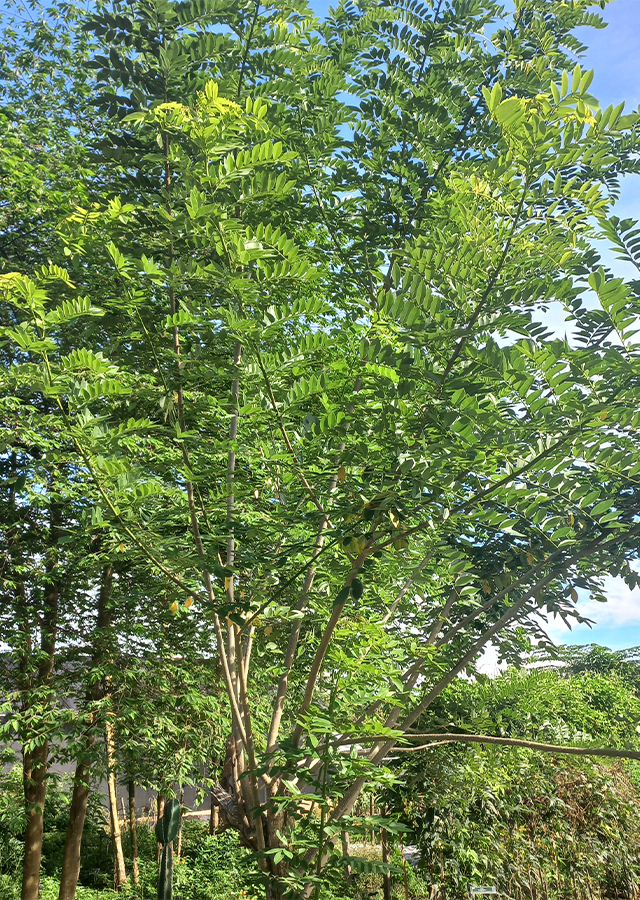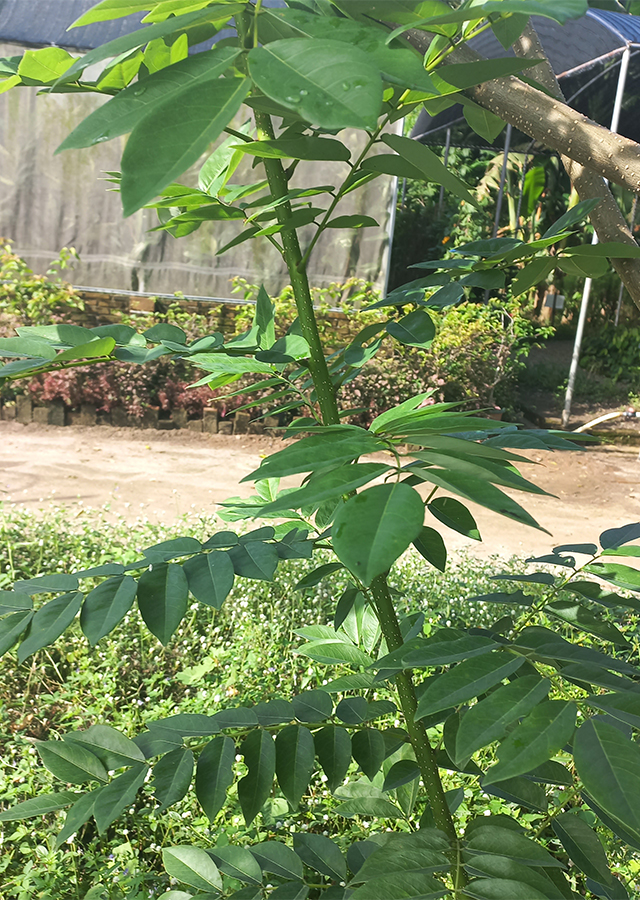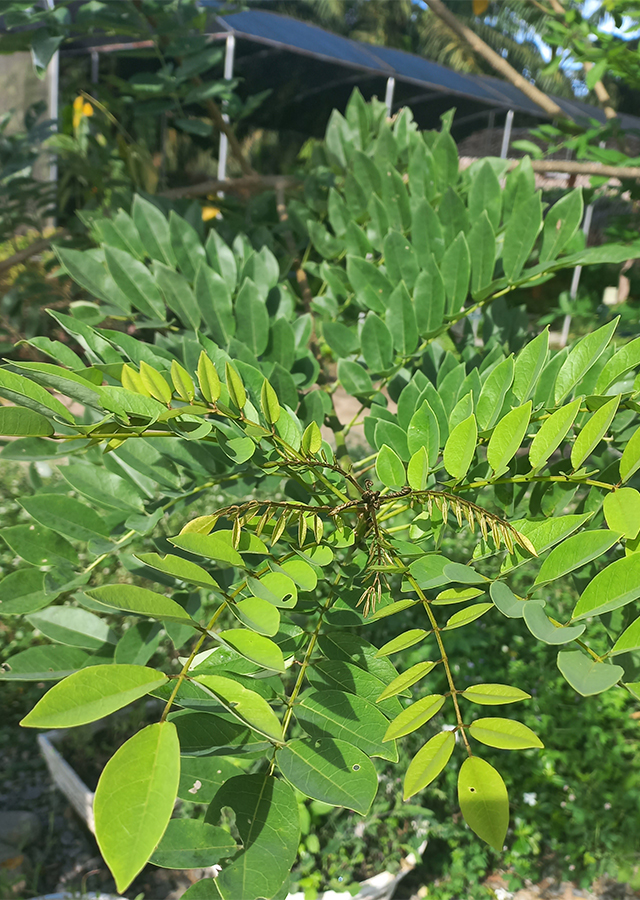Gliricidia
Gliricidia sepium (Jacq.) Kunth
Fabaceae
Location in our garden
Beneficial Weed



Synonym
Gliricidia lambii Fernald
Lonchocarpus roseus (Mill.) DC
Robinia sepium Jacq.
Habitus
Trees. A shrub or small tree with a medium-sized, open crown, thornless, deciduous, able to grow up to about 2 - 15 m in height.
Part Used
Leaves
Bark
Roots
Growing Requirements
Full Sunshine
Habitat
Riverbanks
Coastal
Roadside
Shrublands
Grassland
Terrestrial
Overview
Native to Mexico, Central America, northern South America and the Caribbean. The tree is often cultivated in many tropical countries of Central and South America, South and Southeast Asia, the Pacific islands and Africa. This species is listed as invasive in Australia, Hawaii, the Philippines, Cook Islands, French Polynesia, Tonga, Singapore, Comoros, and Trinidad and Tobago and is also regarded as a potential weed and as a moderate or potentially invasive species in many countries across Asia, Africa, and the West Indies. Gamal is a very valuable multipurpose tree and important component of various agroforestry systems. This species has been widely introduced across tropical and subtropical regions to be used for fuel wood, animal feed, green manure, shade, poles, living fences, erosion control, and as a boundary and support plant. It is a pioneer species that readily colonises open ground and is used for reclaiming Imperata grasslands. The plant grown as an ornamental plant, where it is particularly valued for its generosity in flower and is also uses as traditional medicine. In the Philippines, the juice of the leaves, bark and roots is used to alleviate itches and wounds. Flowers are also used, being cooked locally for human food, as a useful source of nectar for bees. Gamal is considered an important tree in apiculture in several countries.
Vernacular Names
Mata-ratos (Brazilian), Ge li dou (Chinese), Immortelle, Lilas étranger, Madre de cacao (French), Quick stick, St. Vincent plum (Jamaican), Khe falangx, Khe nooyz (Laos), Bunga jepun (Malaysian), Cacaguanance, Cacahuananche, Cacahuanano. Chante, Cocoite, Cuchunuc, Flor de San Jose, Frijolillo, Guie-niiza, Madriado, Mata-raton, Palo de corral, primavera, Sacyab, Sayab, Tunduti, Yaga-le (Mexico), Bala, Balo, Madera negra (Panama), Mae-do-cacau, Planta mae do cacau (Portuguese), Madriado, Mata raton, Palo de hierro, Palo de parque, Piñon florido, Madre de cacao (Spanish), Khae farang (Thai), Hong mai, Sat thu (Vietnamese), Kakawate (Philippine).
Agroecology
Gliricidia is a plant of the moist tropics, often grows on coastal sand dunes, sometimes forming extensive thickets in large areas of shifting sand, river banks, floodplains and fallow land at elevations from sea level up to 2,000 m. It grows best in areas where annual daytime temperatures are within the range 15 - 30 °C, but can tolerate 12 - 44 °C, and a mean annual rainfall in the range 1,200 - 2,300 mm, but tolerates 600 - 3,500 mm. Gliricidia is found on a wide range of soil types from pure sand on coastal dunes to heavy black clays, but is most commonly found on freely drained, rocky, superficial, skeletal, unstratified regasols of volcanic or alluvial origin. It tolerates both alkaline and moderately acidic soils with pH in the range 5,5 - 6,2 (tolerating 4.5 - 8), and also tolerate some waterlogging and low-fertility soils. Gliricidia is grows best in a sunny position.
Morphology
- Roots - taproot.
- Stems - greyish brown or pale whitish grey with raised pale brown lenticels, becoming fissured on boles. The bark on young branches is smooth.
- Leaves - imparipinnate, alternate or sometimes sub-opposite, pinnate, yellow-green, finely hairy rachis. Each leaf consist of about 13 - 21 leaflets. Leaflets are arrowly elliptic to elliptic, rarely broadly elliptic, with a pointed tip and rounded base, larger towards tip of the leaf, with characteristic dark purplish tannin patches scattered, especially on lower surface.
- Flowers - reddish-pink flowers with a deep yellow basal blotch borne on an erect inflorescence along the branches, tends to fade to pale purple upon aging. Racemes are numerous on leafless branches, containing many flowers. It has five-lobed campanulate (bell-shaped) calyx and a typical pea-shaped. The wing and keel petals are also usually pink. There are 10 whitish stamens, 9 united into a tube and one free.
- Fruits - a dehiscent flattened pod about 10 - 15 cm long, strongly compressed, narrowly oblong to oblanceolate, green sometimes tinged maroon and fleshy unripe, drying mid yellow-brown when ripe, and darker orange-brown when mature, opening explosively when dry with the pod valves twisting into tight spirals after dehiscence, contains 3 - 10 seeds.
- Seed - brown-black, flat, and round.
Cultivation
Propagated by seeds. Seeds germinate within 3-10 days.
Chemical Constituents
Formosin, formononetin, gliricidin-6a-gliricidol-9a, medicarpin (pterocarpan), 7,4'-dihydroxy-3'-methoxyisoflavin, 2'O- metilsepiol, tanin, trihidroksiflavon, stigmastanol glucoside and 3'4-dihydroxy-trans-cinnamic acid octacosylester 2, methyl‐3(E)‐pentenyl ether, 3‐methyl‐2‐butanol, 3‐methoxy hexane, 1‐(1‐ethoxyethoxy)‐2‐hexene, 2‐ decanol, coumarin, hexadecanoic acid, essential oil (pentadecanal, (Z)-phytol, methyl linolenate, nonanal, myrtenol, nerolidol).
Traditional Medicinal Uses
- Studies have suggested antimicrobial, anti-scabies, nematicidal, insecticidal, antiviral, acaricidal properties.
- Dermatitis, skin itching: apply juice or decoction of leaves, bark or roots on the skin as antipruritic.
- Fresh leaves applied to the skin as insect repellent.
- As counterirritant: crush leaves and apply as poultice for rheumatic pains, sprains and closed fractures.
- Sap of bark, leaves and roots have been used for wound healing.
- In Guatemala, the bark and leaves are used to treat skin diseases.
- In Guatemala and Costa Rica, bark decoction is used against bacterial and protozoal infections.
- In many folkloric regimens of other countries, used for headache, bruises, burns, colds, cough, fever, fatigue, gangrene, gonorrhea, skin itches and sores, debility, eruptions, erysipelas, fever, fractures, gangrene, headache, itch, prickly heat, rheumatism, skin tumours, ulcers, urticaria and wounds; as antidote, insecticide, insect repellent.
- In Panama, decoction of leaves used in urticaria, rash, burns, and erysipelas.
- In some parts of Nigeria, used for the treatment of sickle cell disease.
Part Used
Reference Sources
- CAB International. 2021. Invasive Species Compendium: Gliricidia sepium (gliricidia). https://www.cabi.org/isc/datasheet/25380#toPictures. 12-09-2021.
- Flora Fauna Web. 2019. Gliricidia sepium. https://www.nparks.gov.sg/FloraFaunaWeb/Flora/2/9/2935. 12-09-2021.
- Useful Tropical Plants Database. 2021. Gliricidia sepium. https://tropical.theferns.info/viewtropical.php?id=Gliricidia+sepium. 12-09-2021.
- Stuartxchange. 2018. Philippine Medicinal Plants: Kakawate. http://www.stuartxchange.org/Kakawati.html. 12-09-2021.


